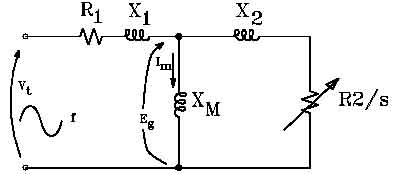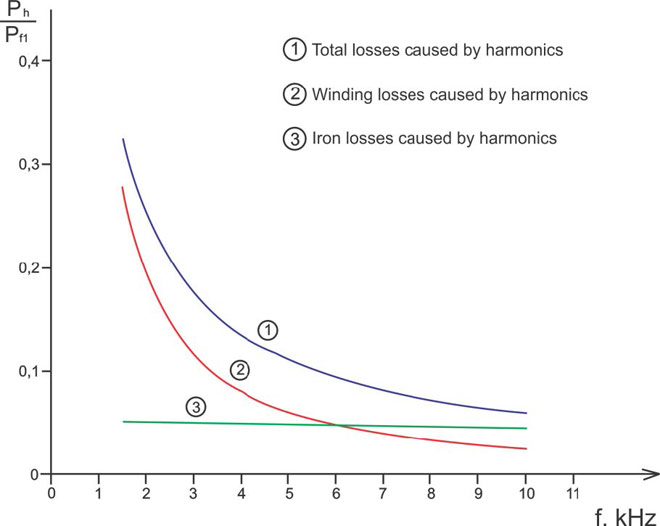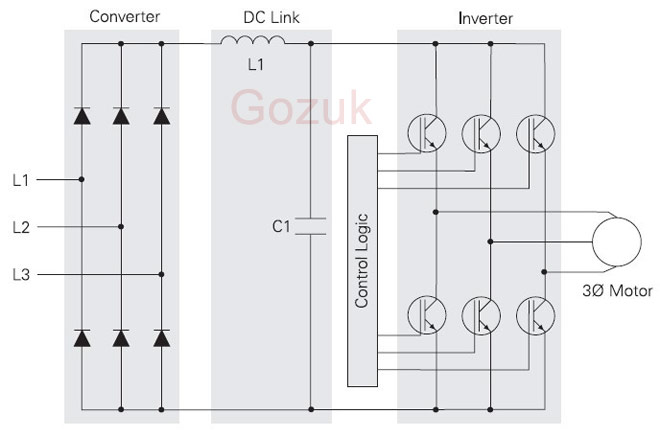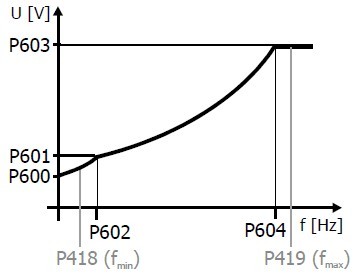VFD current: input side vs. output side
What's the difference between the current measured at the input vs. the output of the Variable Frequency Drive? Is it lower at the input compared to the output? Are common multimeters able to measure the correct output voltage and current?
The VFD uses a PWM output voltage waveform. Most multimeters will measure the peak voltage and calculate the average from that. In order to measure the voltage, a low-pass filter is required to remove the high-frequency component.
At frequencies below 60Hz, the output voltage from the VFD is below the line voltage. Since VIin = VIout (or Powerin = Powerout, Pin = Pout), the output current must be higher than the input current. That is, at half speed, the output voltage is half, so the output current is double.
Except for the losses in the VFD. at one-half speed, the output current is typically slightly less than twice the input current because the losses are greater in the circuit at that speed (perhaps 5% or even 10%?), but the input current will include those losses.
If one limits the current to 130% of a VFD's rating, how will it behave in case there is a short circuit in outgoing cables or if a motor is grounded? Will the inverter limit the current only up to 130%?
The current limit feature will limit the average current but not the peak current. Most modern VFDs will shut down if there is an output short circuit. Some of the older VFDs will burn up.
If the motor 100 HP (75 kW), what is the maximum limit to which the VFD can be selected? What will happen if one selects a VFD in higher than the motor rating. Will it have affect motor windings and mechanical components?
Usually, there is no problem using an oversized VFD with a motor. If the VFD is too large, the VFD may not be able to measure the motor-performance current (and other parameters) accurately. In some VFDs that are closed-loop, sensorless vector, and direct-torque control, there may be an issue (due to measurements) if the VFD is too large. The VFD manufacturer can help you with this. We don't expect any problems with respect to the motor or the driven load.
Is it true that VFDs keeps a constant voltage/ frequency ratio in order to prevent the core from saturating? If a motor has a full load, can you safely increase the voltage without saturating the core?
Yes: the voltage/frequency ratio must not exceed that of rated voltage and frequency in order to prevent saturation. Even if the motor is fully loaded, you must not exceed this ratio for any period of time. If you refer to the equivalent circuit of the motor (see below), you will see that the magnetizing current (Im, which produces the flux) is a shunt component across the incoming supply and is not really affected by load. It is common, however, to operate the motor at lower flux under reduced-load conditions and that way to lower energy consumption and motor heat.

The VFD uses a PWM output voltage waveform. Most multimeters will measure the peak voltage and calculate the average from that. In order to measure the voltage, a low-pass filter is required to remove the high-frequency component.
At frequencies below 60Hz, the output voltage from the VFD is below the line voltage. Since VIin = VIout (or Powerin = Powerout, Pin = Pout), the output current must be higher than the input current. That is, at half speed, the output voltage is half, so the output current is double.
Except for the losses in the VFD. at one-half speed, the output current is typically slightly less than twice the input current because the losses are greater in the circuit at that speed (perhaps 5% or even 10%?), but the input current will include those losses.
If one limits the current to 130% of a VFD's rating, how will it behave in case there is a short circuit in outgoing cables or if a motor is grounded? Will the inverter limit the current only up to 130%?
The current limit feature will limit the average current but not the peak current. Most modern VFDs will shut down if there is an output short circuit. Some of the older VFDs will burn up.
If the motor 100 HP (75 kW), what is the maximum limit to which the VFD can be selected? What will happen if one selects a VFD in higher than the motor rating. Will it have affect motor windings and mechanical components?
Usually, there is no problem using an oversized VFD with a motor. If the VFD is too large, the VFD may not be able to measure the motor-performance current (and other parameters) accurately. In some VFDs that are closed-loop, sensorless vector, and direct-torque control, there may be an issue (due to measurements) if the VFD is too large. The VFD manufacturer can help you with this. We don't expect any problems with respect to the motor or the driven load.
Is it true that VFDs keeps a constant voltage/ frequency ratio in order to prevent the core from saturating? If a motor has a full load, can you safely increase the voltage without saturating the core?
Yes: the voltage/frequency ratio must not exceed that of rated voltage and frequency in order to prevent saturation. Even if the motor is fully loaded, you must not exceed this ratio for any period of time. If you refer to the equivalent circuit of the motor (see below), you will see that the magnetizing current (Im, which produces the flux) is a shunt component across the incoming supply and is not really affected by load. It is common, however, to operate the motor at lower flux under reduced-load conditions and that way to lower energy consumption and motor heat.

How a VFD calculates the exact Speed of motor in Sensor less /DTC mode.
Can you share the formula?
Can you share the formula?
compressor running with vfd modification this is power saving are not
input current is 89 amps and output current is 105 amps why changing amps
running 50 hz frequency this is power saving are not please soon replay
weaare using kwh meater readins are change 15 units difference this is currect are not
input current is 89 amps and output current is 105 amps why changing amps
running 50 hz frequency this is power saving are not please soon replay
weaare using kwh meater readins are change 15 units difference this is currect are not
Post a Comment:
You may also like:
Featured Articles
Variable frequency drive Rectifier
 To understand variable frequency drive (VFD) better, it's necessary to explain some of the main parts of the variable frequency ...
To understand variable frequency drive (VFD) better, it's necessary to explain some of the main parts of the variable frequency ...
 To understand variable frequency drive (VFD) better, it's necessary to explain some of the main parts of the variable frequency ...
To understand variable frequency drive (VFD) better, it's necessary to explain some of the main parts of the variable frequency ...VFD controlled Induction motor ...
 This paper presents a procedure to measure the efficiency on an induction motor fed by a VFD by the all operation range to speed ...
This paper presents a procedure to measure the efficiency on an induction motor fed by a VFD by the all operation range to speed ...
 This paper presents a procedure to measure the efficiency on an induction motor fed by a VFD by the all operation range to speed ...
This paper presents a procedure to measure the efficiency on an induction motor fed by a VFD by the all operation range to speed ...VFD: Pulse Width Modulation (PWM)
 Pulse Width Modulation (PWM) VFDs provide a more sinusoidal current output to control frequency and voltage supplied to an AC ...
Pulse Width Modulation (PWM) VFDs provide a more sinusoidal current output to control frequency and voltage supplied to an AC ...
 Pulse Width Modulation (PWM) VFDs provide a more sinusoidal current output to control frequency and voltage supplied to an AC ...
Pulse Width Modulation (PWM) VFDs provide a more sinusoidal current output to control frequency and voltage supplied to an AC ...Variable frequency drive Advantages & ...
VFDs are good for variable speed, in a water pump this is used to maintain a steady pressure, they will smooth out variances in ...
Variable frequency drive Energy saving
 Energy can be saved in a VFD by reducing the losses in the electric motor or by reducing the energy consumption of the variable ...
Energy can be saved in a VFD by reducing the losses in the electric motor or by reducing the energy consumption of the variable ...
 Energy can be saved in a VFD by reducing the losses in the electric motor or by reducing the energy consumption of the variable ...
Energy can be saved in a VFD by reducing the losses in the electric motor or by reducing the energy consumption of the variable ...
VFD manufacturers

The status display on my VSD is as follows:
329 RPM
30.3A
16.5 Hz
170Nm
131V
The current to motor is at design and I can not increase without tripping the drive.
Please help